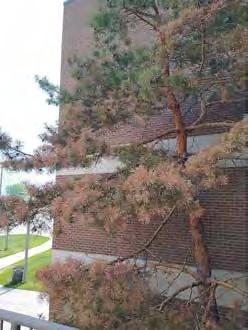
5 minute read
Reducing Winter-Related Injury in Landscape Trees

By: Abiya Saeed, Montana State University Extension Horticulture Specialist
Montana can have harsh winter conditions that can sometimes challenge even our hardiest trees and shrubs, especially if steps aren’t taken to set them up for the best success. Last winter was especially tough on many of our landscape trees and shrubs, and we saw significant amounts of winter injury across the state. Follow these tips to set your trees up for a more successful winter this year by allowing them to harden off and protecting them from common winter-related injuries.
Dieback in Deciduous Trees
Dieback can occur on sensitive shoots and buds during temperature extremes, and can especially be an issue in marginally hardy trees and shrubs. Floral buds are more susceptible to dieback than leaf or stem buds, which can result in a reduction or lack of flowering and fruiting in the following growing season. It can be difficult to completely prevent winter dieback, but a few steps can be taken to reduce the likelihood.
• Select regionally hardy trees, shrubs, and rootstock for your growing climate and make sure that they are well-taken care of and healthy going into winter.
• Marginally hardy plants should be placed in more sheltered locations and, if possible, planted in groups.
• Avoid fertilizing and pruning late summer and fall to reduce the amount of new tender growth going into the winter.
• Make sure trees are watered sufficiently throughout the growing season, and check soil moisture regularly. Watering should continue until the ground freezes. It is especially important to keep watering newly transplanted trees and shrubs because they experience the most water-stress due to their underdeveloped root systems.
Sunscald
Sunscald (also referred to as southwest injury) occurs when the sun heats up the bark of trees, which can begin stimulating cell activity in the winter. As temperatures drop after the sun disappears, these active cells can be killed, which results in cracking and splitting damage in the bark. This is especially likely in younger and newly transplanted trees, heavily pruned trees, as well as dark and thinbarked trees (such as cherries, plums, crabapples, ash, linden, maples, and honey locust). This is also more common in the south and southwest direction, where sun intensity is highest.
• Protect susceptible trees by wrapping their bark in white tree wraps, plastic guards, or white latex paint to reflect the intense sunlight.
o Remove tree wraps and plastic guards in the spring as active growth resumes, to prevent constriction and girdling.
Evergreen Winter Injury
Winter injury (also referred to as winter burn and desiccation) can be an issue for evergreen trees and shrubs, especially during long and dry winters. Unlike deciduous trees and shrubs, evergreens continue to lose moisture through transpiration in the winter. When the ground is frozen, and especially during periods of low humidity, low precipitation, and high winds, these evergreens can lose more moisture than they can replenish, which results in drying out and browning of needles and leaves. Damage is most often seen on the south, southwest, and windward sides of the plant, but can sometimes affect the entire plant. Although all evergreens are susceptible, this can be especially problematic on broadleaf evergreens due to their larger leaf surface area and subsequent potential moisture loss.
• Plant marginally hardy and highly susceptible evergreens in locations protected from high winds and intense winter sun.
• Avoid late summer and fall pruning and fertilizing (which encourages new growth), because new growth is more susceptible to winter injury.
• Make sure trees are watered sufficiently throughout the growing season, so they are not water-stressed going into the fall.
• After letting your trees harden off by slightly reducing watering in September, make sure they receive plenty of water in the fall (October) until hard freeze.
• On sunny winter days during periods of very limited or no snow cover, these evergreen trees may need occasional supplemental watering o Water trees mid-day when temperatures are above 40ºF to replenish moisture lost through transpiration. o Most tree roots are located in the top 6 to 24 inches of the soil and can extend 2-3 times past the ‘footprint’ of the tree. o Water slowly to encourage deeper water penetration into this root zone.
Watering trees at the base/around the trunk is not very effective, as that water is not getting to where it is needed most in the roots. Apply water around the drip-line (the area underneath the circumference of the tree branches) which is also referred to as the critical root zone.
• Barriers such as burlap can be used to protect especially sensitive trees and shrubs, especially if significant winter burn has been a problem in the past.
• Anti-desiccation and anti-transpiration sprays can have limited success, and are not an effective replacement for properly watering your trees.
For more information:
Protecting Trees and Shrubs in Winter: https://extension.umn.edu/planting-and-growingguides/protecting-trees-and-shrubs-winter Fall and Winter Watering: https://extension.colostate.edu/topic-areas/yardgarden/fall-and-winter-watering-7-211/
Article originally appeared in the Montana Nursery & Landscape Association's (MNLA) Fall 2023 Leaflet Newsletter. The MNLA is a non-profit trade association, serving Montana's horticulture industry by providing education, resources, and advocacy. For article reprint requests, contact: info@plantingmontana.com.


